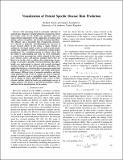Files in this item
Visualization of patient specific disease risk prediction
Item metadata
| dc.contributor.author | Osuala, Richard | |
| dc.contributor.author | Arandelovic, Ognjen | |
| dc.date.accessioned | 2017-05-03T08:30:17Z | |
| dc.date.available | 2017-05-03T08:30:17Z | |
| dc.date.issued | 2017-02-16 | |
| dc.identifier | 249892388 | |
| dc.identifier | fc26ccee-2982-4dbc-a9bb-ed09904f463f | |
| dc.identifier | 85018380124 | |
| dc.identifier | 000403312900060 | |
| dc.identifier.citation | Osuala , R & Arandelovic , O 2017 , Visualization of patient specific disease risk prediction . in IEEE-EMBS International Conference on Biomedical and Health Informatics (BHI) . , 7897250 , IEEE , pp. 241-244 , BHI-2017 International Conference on Biomedical and Health Informatics , Orlando , Florida , United States , 16/02/17 . https://doi.org/10.1109/BHI.2017.7897250 | en |
| dc.identifier.citation | conference | en |
| dc.identifier.isbn | 9781509041794 | |
| dc.identifier.other | ORCID: /0000-0002-9314-194X/work/164896009 | |
| dc.identifier.uri | https://hdl.handle.net/10023/10699 | |
| dc.description.abstract | The increasing trend of systematic collection of medical data (diagnoses, hospital admission emergencies, blood test results, scans etc) by health care providers offers an unprecedented opportunity for the application of modern data mining, pattern recognition, and machine learning algorithms. The ultimate aim is invariably that of improving outcomes, be it directly or indirectly. Notwithstanding the successes of recent research efforts in this realm, a major obstacle of making the developed models usable by medical professionals (rather than computer scientists or statisticians) remains largely unaddressed. Yet, a mounting amount of evidence shows that the ability to understanding and easily use novel technologies is a major factor governing how widely adopted by the target users (doctors, nurses, and patients, amongst others) they are likely to be. In this work we address this technical gap. In particular, we describe a portable, web based interface that allows health care professionals to interact with recently developed machine learning and data driven prognostic algorithms. Our application interfaces a statistical disease progression model and displays its predictions in an intuitive and readily understandable manner. Different types of geometric primitives and their visual properties (such as size or colour), are used to represent abstract quantities such as probability density functions, the rate of change of relative probabilities, and a series of other relevant statistics which the heath care professional can use to explore patients' risk factors or provide personalized, evidence and data driven incentivization to the patient. | |
| dc.format.extent | 812094 | |
| dc.language.iso | eng | |
| dc.publisher | IEEE | |
| dc.relation.ispartof | IEEE-EMBS International Conference on Biomedical and Health Informatics (BHI) | en |
| dc.subject | QA75 Electronic computers. Computer science | en |
| dc.subject | RC Internal medicine | en |
| dc.subject | NS | en |
| dc.subject.lcc | QA75 | en |
| dc.subject.lcc | RC | en |
| dc.title | Visualization of patient specific disease risk prediction | en |
| dc.type | Conference item | en |
| dc.contributor.institution | University of St Andrews. School of Computer Science | en |
| dc.identifier.doi | 10.1109/BHI.2017.7897250 |
This item appears in the following Collection(s)
Items in the St Andrews Research Repository are protected by copyright, with all rights reserved, unless otherwise indicated.

